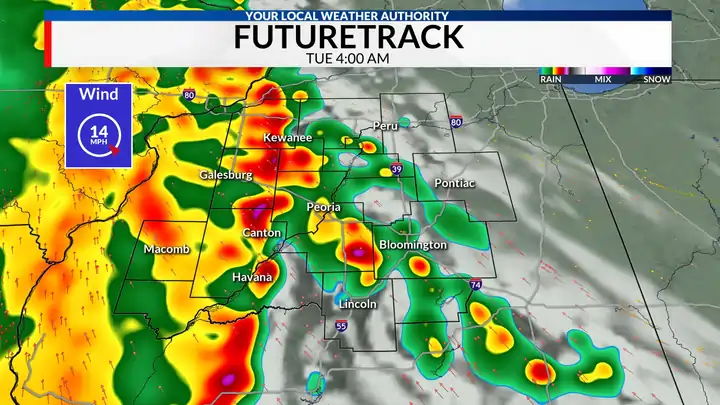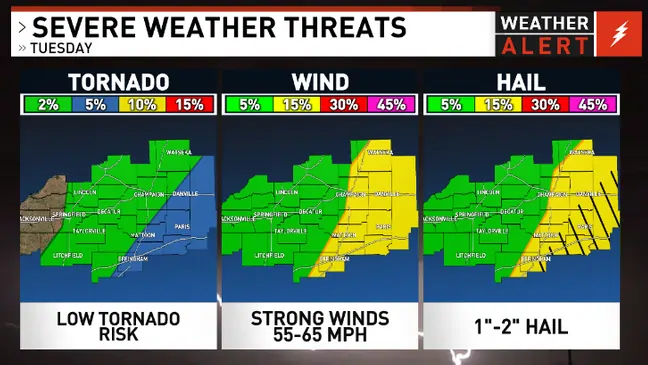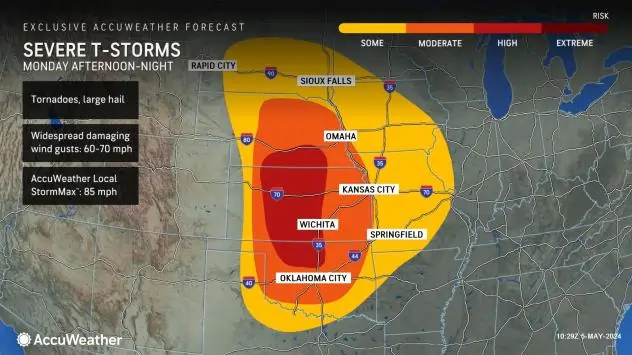Explore the rising threat of powerful storms in Central Illinois. Learn about the growing concern as these extreme weather events impact lives, landscapes, and livelihoods. Discover how communities are addressing the challenges and preparing for a safer, more resilient future.
Central Illinois, with its sprawling plains and vibrant communities, is no stranger to the wrath of Mother Nature. In recent years, the region has witnessed an uptick in the frequency and intensity of powerful storms, posing significant challenges to residents and authorities alike. From destructive tornadoes to severe thunderstorms, Central Illinois has been at the mercy of nature’s fury.

The country’s center is under the influence of a strong low-pressure system that will cause numerous showers and storms as it moves away from the Plains.
Expect largely cloudy skies on Monday night, along with another round of sporadic showers and storms that will build during the night. It is anticipated that a strong to severe squall line will develop, bringing with it the possibility of localized tornadoes, damaging wind gusts, and huge hail.
These storms should mostly develop around 4 a.m., when they move into western areas near the Illinois River. By 6 a.m., they should be moving eastward and threatening Sangamon County and Springfield.
Introduction to Central Illinois
Central Illinois, situated in the heart of the Midwest, boasts a tapestry of rich farmlands, vibrant urban centers, and tightly-knit communities. Its vast expanse encompasses a mosaic of landscapes, from rolling plains to lush forests, offering a scenic backdrop to its inhabitants. Yet, amidst this picturesque setting, Central Illinois faces a formidable adversary: powerful storms.
These weather phenomena, characterized by their ferocious intensity, pose a significant risk to the region’s prosperity and safety. With their ability to unleash devastating force upon the land, these storms serve as a constant reminder of nature’s unpredictable power.
Despite the region’s charm and resilience, the looming threat of such storms underscores the importance of preparedness and vigilance among its residents.
Understanding Powerful Storms
Powerful storms comprise various meteorological events such as tornadoes, thunderstorms, and derechos, each carrying the potential for significant destruction. These weather phenomena are identified by their formidable combination of strong winds, torrential rainfall, and destructive capabilities.

In Central Illinois, these storms emerge from diverse atmospheric conditions, contributing to their unpredictability. Despite advancements in meteorological science, accurately forecasting these storms remains a challenge due to the complex interplay of atmospheric variables. The unique geographical and climatic factors of Central Illinois further exacerbate the difficulty in predicting the onset and severity of these powerful storms.
As a result, residents must remain vigilant and prepared to mitigate the impact of these unpredictable weather events, emphasizing the importance of proactive measures and community readiness in safeguarding lives and property from the merciless forces by nature.
Factors contributing to powerful storms in Central Illinois

Several factors contribute to the occurrence of powerful storms in Central Illinois. The region’s geographical location, with its proximity to the Great Plains and the Mississippi River, makes it susceptible to volatile weather patterns. Additionally, the clash of warm, moist air from the Gulf of Mexico and cold, dry air from the north creates an ideal environment for storm formation.
Impact of Powerful Storms on Central Illinois
Powerful storms wreak havoc on Central Illinois, leaving a trail of destruction in their wake. The impact of these storms can be felt across various sectors, including:
Economic impact
Powerful storms inflict a substantial economic toll, causing billions of dollars in damages to property, infrastructure, and crops. Businesses endure financial losses, while communities grapple with hardships in the aftermath, underscoring the profound impact of these disasters on both local economies and livelihoods
Environmental impact
Powerful storms wreak havoc on the environment, resulting in deforestation, soil erosion, and habitat destruction. Flooding from heavy rainfall endangers wildlife and disrupts ecosystems. The environmental impact underscores the far-reaching consequences of these storms on natural landscapes and biodiversity.
Social impact
Powerful storms leave a profound social impact, touching the lives of residents in diverse ways. Displacement, injuries, and loss of life are tragic outcomes of these events, highlighting their devastating effects. However, communities unite in solidarity, showcasing resilience and support amidst adversity, fostering strength and cohesion in challenging times.
Preparedness Measures for Powerful Storms
Importance of preparedness
Preparedness is paramount when facing the threat of powerful storms. Residents must stay informed, have a plan in place, and stock up on essential supplies to weather the storm safely.
Tips for staying safe during storms
- Seek shelter in a sturdy building or underground facility.
- Avoid windows and doors, and stay away from electrical appliances.
- Listen to the government and must follow safety orders.
- Keep a portable emergency kit stocked with essential supplies such as non-perishable food, water, medications, and a first aid kit.
- Secure outdoor objects and furniture to prevent them from becoming projectiles in high winds.
- Stay informed about weather conditions by monitoring local news, radio broadcasts, or weather apps on your mobile device.
- Designate a safe room or area in your home where family members can gather during severe weather, preferably in a basement or interior room away from windows.
- If caught outdoors during a storm, seek shelter in a sturdy building or vehicle.
- Avoid seeking shelter under trees or near tall structures that may pose a risk of falling debris.
- Practice electrical safety by unplugging appliances and electronics to prevent damage from power surges or lightning strikes.
Role of Technology in Storm Forecasting
Advances in storm prediction
Advancements in meteorological science have revolutionized storm forecasting, allowing meteorologists to predict the path and intensity of storms with greater accuracy. Doppler radar, satellite imagery, and computer models provide invaluable data for forecasting.
Tools and technologies used
Meteorological agencies utilize a range of tools and technologies to monitor weather conditions and issue warnings to the public. From mobile apps to emergency alert systems, these resources play a crucial role in keeping communities safe.
Community Response and Support Systems
Government initiatives
Government agencies at the local, state, and federal levels are pivotal in responding to and recovering from disasters. Their coordinated efforts through emergency management agencies ensure swift and effective relief operations for affected communities.
These agencies provide essential assistance, including shelter, food, and medical aid, to those impacted by disasters. Moreover, they play a crucial role in facilitating the rebuilding process, helping communities recover and rebuild infrastructure and essential services.
By working together and leveraging resources, government initiatives aim to restore normalcy and resilience in the aftermath of calamities, ensuring the well-being and safety of citizens.
Community organizations
Community organizations, including non-profits, volunteer groups, and faith-based organizations, are instrumental in aiding communities during and after powerful storms. They provide essential support such as shelter, food distribution, and medical assistance to those affected by the disaster.
These organizations mobilize resources and volunteers to offer immediate relief and long-term recovery efforts, ensuring that impacted individuals receive the assistance they require. Their dedication and outreach play a vital role in fostering resilience and rebuilding communities in the aftermath of devastating weather events
Recovery and Rebuilding Efforts
Post-storm recovery strategies
Rebuilding in the aftermath of powerful storms is a challenging endeavor that requires coordination and collaboration. Communities come together to assess damages, restore essential services, and rebuild infrastructure.
Rehabilitation of affected areas
Efforts to rehabilitate affected areas focus on restoring normalcy and fostering resilience. From repairing damaged homes to revitalizing public spaces, these initiatives aim to rebuild communities stronger than before.
Conclusion
n conclusion, the threat posed by powerful storms to Central Illinois cannot be understated, affecting lives, livelihoods, and landscapes. Yet, through proactive preparedness measures, utilization of technology, and the cultivation of community resilience, we can minimize the impact of these severe weather events.
By prioritizing safety and cooperation, we pave the way for a more resilient future where communities can withstand and recover from the challenges posed by powerful storms, ensuring the well-being and security of all residents in Central Illinois.
Unique FAQs
- What should I include in an emergency preparedness kit for powerful storms?
- An emergency preparedness kit should include essential items such as non-perishable food, water, medications, flashlights, batteries, and a first aid kit.
- How can I stay informed about storm warnings and alerts?
- Stay tuned to local weather forecasts and sign up for emergency alert systems that provide timely updates on storm warnings and evacuation orders.
- What should I do if a powerful storm is approaching my area?
- Seek shelter in a sturdy building or underground facility, away from windows and doors. Follow evacuation orders issued by local authorities, if necessary.
- How long does it take for a community to recover from a powerful storm?
- The recovery process varies depending on the severity of the storm and the extent of the damages. It can take weeks, months, or even years for a community to fully recover and rebuild.
- What role can individuals play in supporting their community during and after powerful storms?
- Individuals can volunteer with local organizations, donate to relief efforts, and offer assistance to neighbors in need to support their community during and after powerful storms.
Follow for more information
